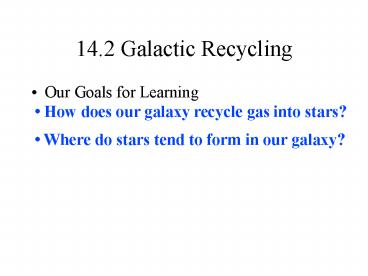14.2 Galactic Recycling - PowerPoint PPT Presentation
Title:
14.2 Galactic Recycling
Description:
14.2 Galactic Recycling Our Goals for Learning How does our galaxy recycle gas into stars? Where do stars tend to form in our galaxy? How does our galaxy ... – PowerPoint PPT presentation
Number of Views:83
Avg rating:3.0/5.0
Title: 14.2 Galactic Recycling
1
14.2 Galactic Recycling
- Our Goals for Learning
How does our galaxy recycle gas into stars?
Where do stars tend to form in our galaxy?
2
How does our galaxy recycle gas into stars?
3
Star-gas-star cycle Recycles gas from old stars
into new star systems
4
High-mass stars have strong stellar winds that
blow bubbles of hot gas
5
Lower mass stars return gas to interstellar space
through stellar winds and planetary nebulae
6
X-rays from hot gas in supernova remnants reveal
newly-made heavy elements
7
Supernova remnant cools and begins to emit
visible light as it expands New elements made
by supernova mix into interstellar medium
8
Multiple supernovae create huge hot bubbles that
can blow out of disk gas cooling in the halo can
rain back down on disk.
9
Atomic hydrogen gas forms as hot gas cools,
allowing electrons to join with
protons. Molecular clouds form next, after gas
cools enough to allow to atoms to combine into
molecules
10
- Molecular clouds in Orion
- Composition
- Mostly H2
- About 28 He
- About 1 CO
- Many other
- molecules
11
Gravity forms stars out of the gas in molecular
clouds, completing the star-gas-star cycle
12
Radiation from newly formed stars is eroding
these star-forming clouds
13
Summary of Galactic Recycling
- Stars make new elements by fusion
- Dying stars expel gas and new elements, producing
hot bubbles (106 K) - Hot gas cools, allowing atomic hydrogen clouds to
form (100-10,000 K) - Further cooling permits molecules to form, making
molecular clouds (30 K) - Gravity forms new stars (and planets) in
molecular clouds
Gas Cools
14
We observe star-gas-star cycle operating in Milky
Ways disk using many different wavelengths of
light
15
(No Transcript)
16
(No Transcript)
17
(No Transcript)
18
(No Transcript)
19
(No Transcript)
20
Gamma rays show where cosmic rays from supernovae
collide with atomic nuclei in gas clouds
21
Where do stars tend to form in our galaxy?
22
Ionization nebulae are found around short-lived
high-mass stars, signifying active star formation
23
Reflection nebulae scatter the light from
stars. Why do reflection nebulae look blue,
even when the stars near them aren't blue?
24
Reflection nebulae scatter the light from
stars Why do reflection nebulae look bluer
than the nearby stars? For the same reason that
our sky is blue!
25
(No Transcript)
26
(No Transcript)
27
(No Transcript)
28
(No Transcript)
29
Spiral arms are waves of star formation
30
Spiral arms are waves of star formation Gas
clouds get squeezed as they move into spiral
arms Squeezing of clouds triggers star
formation Young stars flow out of spiral arms
31
14.4 The Mysterious Galactic Center
- Our Goals for Learning
What lies in the center of our galaxy?
32
Activity 33, page 113-115
- Question 3A pinpoint the location of the center
of our galaxy using the two longest acceleration
vectors shown in Figure 1.
33
(No Transcript)
34
(No Transcript)
35
(No Transcript)
36
Stars appear to be orbiting something massive but
invisible a black hole. Orbits of stars
indicate a mass of about 4 million MSun
37
(No Transcript)
38
What have we learned?
- Where do stars tend to form in our galaxy?
- Active star-forming regions, marked by the
presence of hot, massive stars and ionization
nebulae, are found preferentially in spiral arms.
The spiral arms represent regions where a spiral
density wave has caused gas clouds to crash into
each other, thereby compressing them and making
star formation more likely.
39
What have we learned?
- What lies in the center of our galaxy?
- Motions of stars near the center of our galaxy
suggest that it contains a black hole about 3 to
4 million times as massive as the Sun. The black
hole appears to be powering a bright source of
radio emission known as Sgr A.































